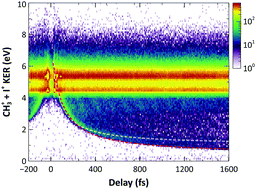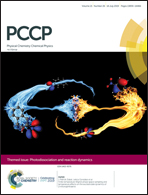Time-resolved imaging of bound and dissociating nuclear wave packets in strong-field ionized iodomethane
Abstract
We report the results of a time-resolved coincident ion momentum imaging experiment probing nuclear wave packet dynamics in the strong-field ionization and dissociation of iodomethane (CH3I), a prototypical polyatomic system for photochemistry and ultrafast laser science. By measuring yields, kinetic energies, and angular distributions of CH3+ + I+ and CH3+ + I++ ion pairs as a function of the delay between two 25 fs, 790 nm pump and probe pulses, we map both, bound and dissociating nuclear wave packets in intermediate cationic states, thereby tracking different ionization and dissociation pathways. In both channels, we find oscillatory features with a 130 fs periodicity resulting from vibrational motion (C–I symmetric stretch mode) in the first electronically excited state of CH3I+. This vibrational wave packet dephases within 1 ps, in good agreement with a simple wave packet propagation model. Our results indicate that the first excited cationic state plays a key role in the dissociative ionization of CH3I and that it represents an important intermediate in the sequential double and multiple ionization at moderate intensities.

- This article is part of the themed collections: 2019 PCCP HOT Articles and Photodissociation and reaction dynamics


 Please wait while we load your content...
Please wait while we load your content...
